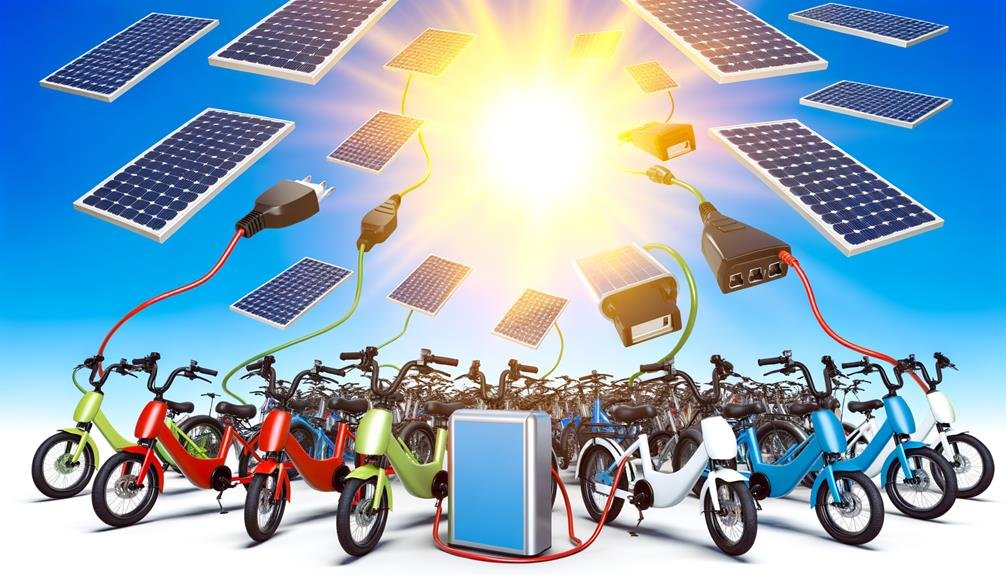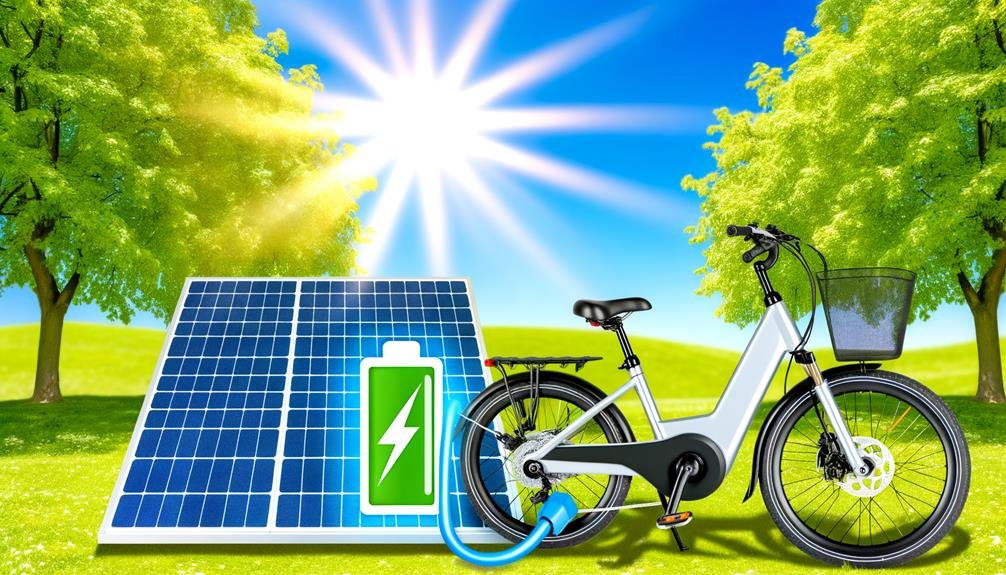Charles Miller is a veteran bike enthusiast with over 12 years of experience dealing with bikes as a mechanic. Despite immense love and expertise for...
We're stepping into a realm where the sun isn't just the source of light and life, but also a potential fuel for our daily commutes.
Yes, we're talking about charging electric bikes with solar panels.
As we transition towards a greener future, it's worth exploring how we can harness solar power to keep our e-bikes running.
Is it as straightforward as it sounds? Or are there complexities we need to consider?
Let's peel back the layers of this intriguing possibility.
- Key Takeaways
- Understanding Solar Energy and E-bikes
- The Science Behind Solar Charging
- Solar Charger Types for E-bikes
- Step-by-Step Solar Charging Process
- Best Solar Panels for E-bikes
- Advantages of Solar Charging
- Potential Challenges and Solutions
- Real-life Solar Charging Experiences
- Future of Solar Power in E-bikes
- Frequently Asked Questions
- Conclusion
Key Takeaways
- Solar charging for e-bikes offers a sustainable and eco-friendly alternative to traditional charging methods, reducing reliance on fossil fuels and carbon emissions.
- Solar charging provides a renewable and portable charging solution, enabling off-grid charging anywhere, even in remote locations.
- Solar charging offers cost-saving benefits and energy independence, making it a promising solution for the future.
- The efficiency of solar charging depends on factors like sunlight angle, battery capacity, and the selection of the appropriate solar charger.
Understanding Solar Energy and E-bikes
Often, we overlook the importance of solar energy in powering e-bikes, despite its potential to offer a sustainable, cost-effective, and eco-friendly alternative to traditional charging methods. As we delve into understanding solar energy and e-bikes, we see that solar panels provide green energy, reducing our reliance on fossil fuels and carbon emissions. They offer a renewable and portable charging solution, enabling us to charge an electric bike with a solar panel anywhere, even off-grid.
Connecting e-bikes to solar chargers is straightforward. We use a compatible charging cord and plug it into the solar generator. By ensuring the generator receives sunlight, we're able to offer a convenient and eco-friendly solution to eBike Solar charging.
The benefits of this method extend beyond the environment. E-bikes provide a cost-effective, pedal-assisted alternative to traditional transportation, with a range suitable for various activities. Solar Charging offers the possibility for off-grid adventures, emergency preparedness, energy independence, and cost-saving benefits. We're not just saving money; we're investing in our planet's future.
Embrace the power of solar energy, and join us in this sustainable e-biking revolution.
The Science Behind Solar Charging
We're about to explore the science behind solar charging.
Solar panels harness sunlight and convert it into electricity, which can then be used to charge an electric bike.
It's a process that involves photovoltaic cells, energy conversion, and efficient power management.
Understanding Solar Power
Harnessing the power of sunlight, solar panels convert this abundant natural resource into electricity through a fascinating process known as the photovoltaic effect. This process is integral to understanding solar power and how it can be used to charge devices like electric bikes.
Here's the science of it:
- Solar energy is captured in solar cells, which interact with light particles (photons) and convert them into electrical energy.
- Factors such as the quality of solar cells, angle of sunlight, and panel orientation influence the efficiency of this conversion process.
- The generated power is regulated by a charge controller and stored in batteries for later use.
In essence, solar power offers a clean, renewable way to power our lives, making it a promising solution for the future.
Solar Charging Mechanism
Building on our understanding of solar power, let's explore how this energy conversion process is harnessed in the charging of electric bikes.
The solar charging mechanism begins with solar panels absorbing sunlight. These panels, packed with photovoltaic cells, convert sunlight into electricity via the photovoltaic effect. This effect is manifested when sunlight particles strike the solar cells, creating an electric current.
This direct current is then transformed into alternating current using an inverter, which can efficiently charge an electric bike battery. To prevent overcharging and optimize power transfer, charge controllers regulate the electricity flow.
However, the efficiency of solar charging hinges on various factors, from the angle of sunlight to the capacity of the bike's battery.
Solar Charger Types for E-bikes

Let's delve into the different types of solar chargers suitable for e-bikes, ranging from lightweight amorphous silicon solar panels to the multifunctional BioLite CampStove 2. These solar charger types for e-bikes have been developed to cater to the unique needs of Electric bikes' users, ensuring efficient e-bike charging.
Amorphous silicon solar panels are lightweight, making them perfect for mobile charging. They offer the convenience of charging your e-bike on the move.
Crystalline foldable solar panels, on the other hand, provide a higher voltage output, reducing the time required to charge an eBike.
The BioLite CampStove 2 is a multipurpose solar charger, offering the ability to cook and heat while your e-bike charges.
- The QuietKat Solar Power Charger is a high-performance option, rated for 150W. It offers more power than typical e-bike chargers.
- The Anker 555 Solar Generator is designed for outdoor use. With a lifespan of over 10 years and multiple charging options, it's a versatile choice for charging e-bikes.
- The BioLite CampStove 2 not only charges your e-bike but also serves multiple purposes, including cooking and heating, making it a multifunctional choice.
Step-by-Step Solar Charging Process
Let's now explore the step-by-step solar charging process for electric bikes.
We'll begin by discussing the basics of solar charging, followed by the selection of an optimal solar panel.
Then, we'll outline the most efficient method for charging your e-bike using solar power.
Understanding Solar Charging Basics
To harness the power of the sun for charging your electric bike, it's crucial to understand the basic steps of the solar charging process.
First, we select the right solar charger for our e-bike, considering factors like power output and portability.
Then, we position the solar panel in an area with maximum sunlight exposure. This step is crucial for efficient charging.
Lastly, we connect our electric bike to the solar charger using suitable cables.
This process allows the solar panel to convert sunlight into electricity, charging our e-bike. We monitor the charging indicators on the solar charger to know when our e-bike is full.
Optimal Solar Panel Selection
Having grasped the basics of solar charging, we can now focus on the crucial first step: selecting the optimal solar panel for our electric bike.
Optimal solar panel selection involves assessing compatibility, efficiency, portability, and durability. Ensuring your solar panel's output matches your eBike's charging specifications is vital. A high wattage output and efficient energy conversion are necessary for consistent charging.
Foldable solar panels offer the advantage of easy transport and storage, enhancing our eBike with solar charging mobility. It's also essential to verify the panel's charging time and capacity under various sunlight conditions.
Lastly, integrated features like built-in charge controllers and USB ports offer versatility when we connect our solar panel for charging.
Efficient E-Bike Charging Method
Diving into the step-by-step process, we first focus on picking the right solar charger for our e-bike, considering factors like power output, portability, and the type of solar cells used. This efficient e-bike charging method ensures optimal Solar input and effective charging.
We then position the solar charger in an area with maximum sunlight exposure.
Next, using the proper cables, we connect the e-bike to the solar charger.
Finally, we allow the sun to power our e-bike, keeping a close eye on the charging indicators.
As you can see, to charge an electric bike with a solar panel isn't rocket science. With the right ebike chargers, we can all contribute to a greener planet.
Best Solar Panels for E-bikes
When it comes to e-bikes, not all solar panels are created equal, and some are simply better equipped for the job. If you're looking to charge your eBike with solar, we've identified the best solar panels for e-bikes.
The Jackery Solar Generator 2000 Pro tops our list, offering a whopping 4,400 watts peak power for quick charging. It's followed closely by its sibling, the Jackery Solar Generator 1500 Pro. Providing 1,800 watts, it's built with durable and fireproof material, ensuring longevity and safety.
For those seeking compact solutions, lightweight and flexible solar panels offer off-grid charging, making them great portable solar chargers. They're efficient, easy to lug around, and perfect for those adventurous rides.
Regardless of the solar panel you choose, pairing it with a Genasun Boost charge controller is highly recommended. It prevents overcharging and optimizes power usage from the panels, protecting your e-bike's battery.
In essence, charging an electric bike with solar isn't just possible, but advantageous. It offers a portable and sustainable solution, bringing you one step closer to energy independence.
After all, isn't it appealing to ride your e-bike knowing you're powered by the sun?
Advantages of Solar Charging

Building on the idea of harnessing solar energy for e-bike charging, let's explore the numerous advantages this method offers.
The usage of solar generators to charge the battery of your e-bike provides a plethora of benefits that aren't only environmentally friendly but also cost-effective.
- The most significant advantage of solar charging is its sustainability. You can use solar energy indefinitely without depleting natural resources, unlike conventional power sources. This gives us a sense of energy independence and ensures a brighter, cleaner future.
- Solar charging is green and clean. It reduces our dependence on fossil fuels, thus minimizing harmful carbon emissions. By using solar power, we're actively contributing to a sustainable future.
- The beauty of solar charging is its mobility. Whether you're in the city or off-the-grid, you can easily charge your e-bike anywhere under the sun. This enhances convenience and expands the possibilities for adventure.
Potential Challenges and Solutions
While solar charging offers many benefits, it's crucial to acknowledge the potential challenges and find effective solutions for a smooth and efficient charging process. On a sunny day, charging your eBike with a solar panel can seem like an ideal solution, but there are potential challenges and solutions to consider.
| Challenges | Solutions |
|---|---|
| Solar panel size and fragility | Lightweight, flexible solar panels |
| Charging time and efficiency | Higher voltage output panels, solar generator |
| Voltage compatibility and MPPTs | High-quality solar charge controller |
| Cost and practicality | Reliable, efficient portable solar chargers |
Solar panels can be large and fragile, making transport a challenge. Lightweight, flexible models are a solution. Charging time can be lengthy, but this can be mitigated with higher voltage output panels and a solar generator. Voltage compatibility can be an issue, but a high-quality solar charge controller, like the Genasun Boost, can help. Lastly, solar charging can be costly and impractical, but investing in a reliable, efficient portable solar charger can resolve this.
Real-life Solar Charging Experiences

Harnessing the power of the sun, many users have successfully charged their electric bikes with portable solar chargers, effectively extending their range and usage during outdoor adventures. Real-life experiences suggest that using solar to power your eBike can offer a practical, reliable, and sustainable solution.
Here's a snapshot of some experiences:
- In off-grid trips and remote locations, users have turned their eBike to the solar panel for power. Despite the lack of traditional electricity sources, their rides continued uninterrupted.
- Positive feedback about the convenience of solar chargers abounds. Riders have marveled at the freedom offered by not being tied to power outlets.
- Acknowledging the longer charging time due to solar power, many still consider it a viable trade-off for the benefits.
For those of us who seek to belong in a more sustainable world, these real-life anecdotes show that solar charging is more than a possibility—it's a practical, green solution for extending the life of our eBikes. While the longer charging time may present a small challenge, the freedom and sustainability of solar charging make it a compelling choice for many eBike users.
Future of Solar Power in E-bikes
As we look towards the future of solar power in e-bikes, it's clear that this renewable energy source has the potential to revolutionize how we charge and use our electric bikes. Innovations in technology are making it possible to charge an electric bike with solar panels that are smaller, more efficient, and user-friendly.
Portable solar chargers are becoming a popular option for e-bike users, providing a convenient and eco-friendly way to keep our bikes powered up. Not to mention, they free us from the grid, allowing us to use our e-bike without worrying about finding a power source.
We're also seeing advancements in solar generators. These devices, like the Jackery Solar Generator 2000 Pro, provide high peak power levels and rechargeable options, ensuring we can charge our e-bikes quickly and efficiently.
But it's not just about the panels and generators. The future of solar power in e-bikes also includes improved solar charge controllers. These devices protect our e-bike batteries, optimize power usage, and ensure safe charging.
As we move forward, we're confident that solar power will play a bigger role in how we use and charge our e-bikes.
Frequently Asked Questions
How Many Solar Panels Does It Take to Charge an Ebike?
We're assessing factors like solar efficiency rates, panel placement considerations, battery capacity, and climate impact analysis. It's typically one to three panels, but it can vary based on these specifics and your bike's requirements.
How Do You Charge an Electric Bike off the Grid?
Sure, we can charge our eBikes off-grid. Using solar powered pedalling for sustainable cycling, we plug our bikes into a solar generator. It's green charging at its finest, perfect for our off-grid touring adventures.
What Size Inverter Do I Need to Charge an Electric Bike?
We'll need to select an optimal inverter that matches our bike's specifications for efficient charging speed. It's crucial that the inverter's wattage equals or surpasses the solar panel's output for seamless charging.
Are There Portable Chargers for Electric Bikes?
Yes, there are portable chargers for electric bikes. They're essential for bike touring. Although solar power has limitations, our durable chargers pass strict tests and are perfect for off-grid living. We're all in this together.
Conclusion
So, surely solar charging serves as a sustainable solution for our e-bikes. Besides being kind to our planet, it provides us portability and practicality.
However, there are hitches to handle, with varying weather and wattage. With continual technological advancements, we believe that these bumps will be smoothed soon.
In summary, solar power provides a promising, pollution-free pathway for powering our electric bikes.

Charles Miller is a veteran bike enthusiast with over 12 years of experience dealing with bikes as a mechanic. Despite immense love and expertise for his Tacoma, he rides his Trek Ebike more. Anytime you meet him, you’ll either hear him talking about Bikes, or writing about all things bikes and cars on this blog.
More Posts


